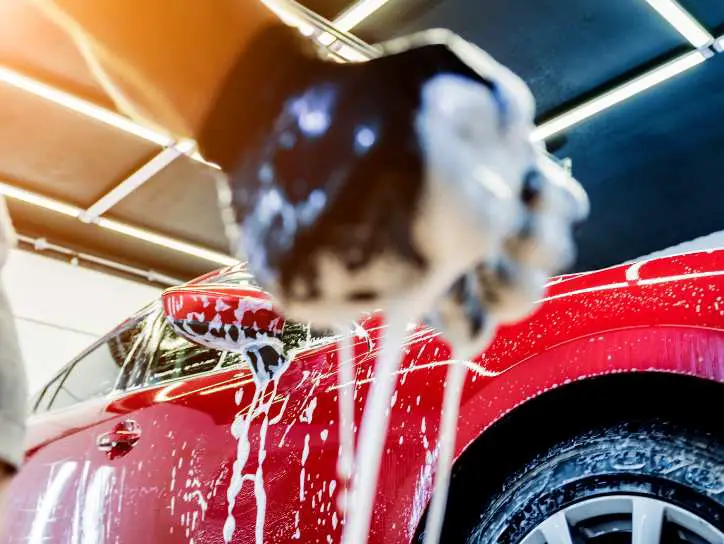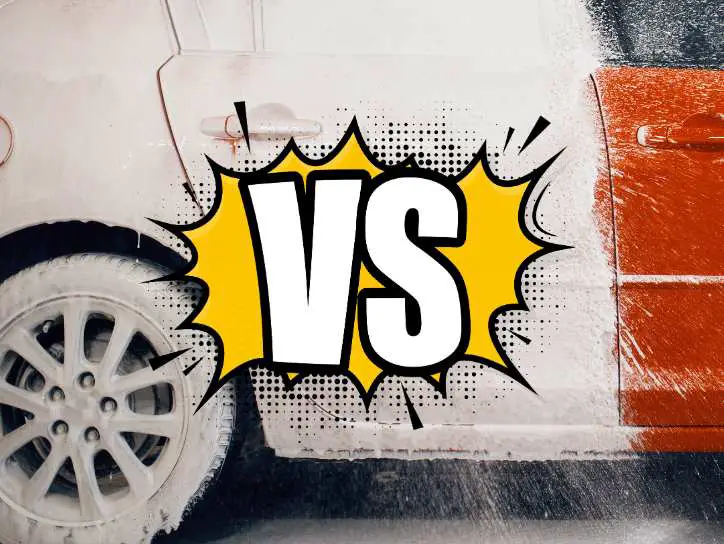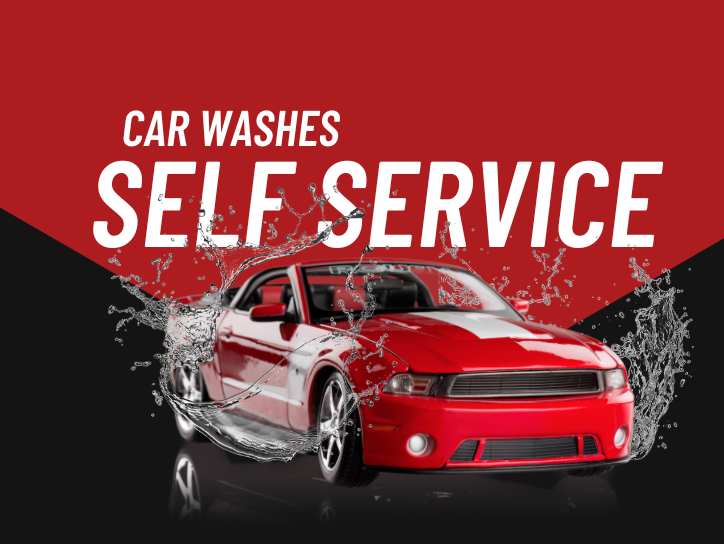Tired of never-ending queues at conventional car washes, unnecessary bills, and the constant worry about whether your car is getting the care it truly deserves?
As a fellow car enthusiast, I understand the challenges of keeping your ride looking its best without overspending.
Self-service car washes are affordable and offer hands-on care for car owners in need of a quick wash.
In this article, you will understand about self-service car wash, its benefits and other related items.
Not only have I listed tips to save money at the self-service car wash, but I’ve also included my personally tried techniques to make your experience a satisfying and effective one.
Let’s skip and understand more details, shall we?
What is a Self-Service Car Wash?

A self-serve car wash is where vehicle owners can wash their vehicles using the provided equipment and resources.
Unlike traditional car wash services where attendants or automated systems wash the vehicles, a self-serve or manual car wash allows customers to take control of the washing process.
Usually, vehicle owners clean vehicles with a high-pressure washing machine, hose, foam brush, microfiber, etc.
Benefits of a Self-Service Car Wash
- Cost Savings: One of the primary benefits of a self-serve car wash is cost savings. Instead of paying for a professional car wash service, customers like you/me can use their labour to clean their vehicles, reducing the overall cost of car maintenance.
- Quality Wash: You are responsible for washing the car and it has been observed that a self-service car wash is significantly better compared to automation. You can personally control the cleaning process, ensuring attention to detail. This hands-on approach allows for targeted cleaning of specific areas, resulting in a more thorough and satisfying wash.
- Time Flexibility: With a self-serve car wash, customers have the flexibility to wash their vehicles at a time that is convenient for them. This is especially beneficial for those with busy schedules who may not be able to visit a professional car wash during regular business hours.
- Learning Experience: For those who enjoy taking care of their vehicles, using a self-serve car wash can be a learning experience. It allows car owners to understand the details of proper car cleaning, including techniques and products that work best for their specific vehicle.
- Avoidance of Scratches and Damage: Some car owners prefer self-serve car washes because they can personally control the cleaning tools, minimizing the risk of scratches or damage to their vehicles. Automated car washes may not always be as gentle, and the brushes used could potentially cause scratches.
- Control and Customization: Self-serve car wash facilities offer users control over the entire washing process. Customers can choose specific cleaning products, adjust the water pressure, and focus on areas that need extra attention. This level of control allows for a more customized and thorough cleaning experience.
- Environmentally Friendly: Usually, automated car washing facilities wastewater in normal washing operations. Other side, thanks to manual efforts, self-serve is environmentally friendly. However, automated facilities also incorporate water recycling systems and use environmentally friendly cleaning products to minimize impact.
Comparison of Self-Service & Automated Car Wash

| Features | Self-Service Car Wash | Automated Car Wash |
| User Control | Users have full control over the washing process, allowing for customization and attention to detail | Washing process is automated, providing a standardized and consistent experience for all vehicles |
| Cost | Generally, more cost-effective as users pay for time and resources, reducing labour costs | May be more expensive due to automated machinery and professional service |
| Flexibility | Users can wash their vehicles at any time, providing flexibility to fit personal schedules | Operating hours may be limited, and wait times during peak hours are possible |
| Environmental Impact | Often designed with eco-friendly features like water recycling, minimizing environmental impact | May use more water, and some automated systems may have a higher environmental footprint |
| Learning Experience | Offers a learning opportunity for car owners to understand proper cleaning techniques | Limited learning experience as the process is automated and controlled by the system |
| Quality of Wash | Users can achieve a high-quality wash by personally addressing specific areas and using preferred techniques | Standardized washing may not address specific concerns, potentially resulting in less detailed cleaning |
| Scratch Risk | Lower risk of scratches as users control the cleaning tools, minimizing potential damage | Automated brushes and equipment may carry a slight risk of causing scratches or damage |
| Waiting Time | Immediate access to washing bays, eliminating the need to wait in line | Possibility of waiting during peak hours as washes are conducted sequentially |
| Accessibility | 24/7 convenience | Operating hours may be restricted, limiting accessibility – depends on your location |
Also read:
How Self-Service Car Wash Works?
- Nearby Car Wash: Please select a well-known brand that is located near your current location.
- Payment and Access: Self-service car washes typically operate using coin, token, credit, or mobile payment systems. Users purchase a set amount of time or a certain number of cycles depending on the facility.
- Prepare and Gather Supplies: Collect supplies, including car wash soap, a bucket, sponge or wash mitt, wheel cleaner, tire brush, hose or pressure washer, and microfiber towels.
- Pre-Rinse and Wheel Cleaning: You can begin by pre-rinsing the vehicle using a hose or pressure washer. Now, apply a wheel cleaner and use a tire brush to clean the wheels. Rinse thoroughly. You can also learn about safety while using a Pressure Washer and Time to wash your car.
- Soap Application and Scrubbing: Prepare a soapy solution in a bucket and apply soap with a sponge or wash mitt, scrubbing the vehicle section by section.
- Rinse and Dry: Rinse off soap using a hose or pressure washer, starting from the top. Let your vehicle dry or use a microfiber towel, blotting gently.
- Interior Cleaning (Optional): Clean the car’s interior using appropriate cleaning products.
- Final Inspection and Waste Disposal: Once done, you should inspect the vehicle for any remaining normal or hard spots.
Also read:
- The ideal frequency of washing your vehicle
- Which soap is better to wash your car? Let’s understand in detail
Precautions Before Using Self-Service Car Washing
- Check for Vulnerable Areas: Inspect your vehicle for vulnerable areas, such as loose trim, antenna, or decals that may be sensitive to high-pressure water.
- Avoid Direct Spray on Seals: Be cautious not to directly spray high-pressure water into gaps around windows and doors to prevent water intrusion.
- Mind the Exhaust Pipe: Avoid directing water into the exhaust pipe to prevent potential damage.
- Check for Leaks: Before washing, check for any existing leaks or issues that could be exacerbated by water pressure.
- Protect Electronic Components: Avoid spraying water directly onto sensitive electronic components, such as sensors or the engine control unit.
- Watch for Loose Items: Secure loose items, like antennas or roof racks, before starting the wash to prevent damage.
- Inspect Tire Pressure: Regularly check and maintain proper tire pressure. Avoid using excessively high-pressure water on tires.
- Mind the Sunroof: If your vehicle has a sunroof, ensure it is closed to prevent water from entering the interior.
- Avoid Excessive Pressure on Painted Surfaces: While scrubbing, use a gentle touch to avoid damaging painted surfaces.
- Inspect Wipers: Ensure windshield wipers are in good condition. Avoid applying excessive force when cleaning around them.
- Check for Rust or Corrosion: Regularly inspect your vehicle for signs of rust or corrosion, and pay extra attention to these areas during the wash.
- Protect Convertible Tops: If your vehicle has a convertible top, follow manufacturer guidelines for cleaning to preserve the material and mechanisms.
Essential Tips for Sel-Service Car Washing
- Choose the Right Bay: Make sure to select a washing bay that offers the features you need, such as wax or tire cleaning.
- Read the Instructions: Before starting, take the time to read and understand the guidelines in the washing bay.
- Top-Down Approach: Begin washing your car from the top and work your way down to avoid getting dirt and debris on areas you’ve already cleaned. This is a tested and recommended approach.
- Separate Wheels: Use separate tools or buckets to clean your wheels and tires to avoid contamination.
- Mind Water Usage: Try to use water and time efficiently to reduce waste.
- Apply Wax (if available): Consider applying wax or sealant to protect your car’s paint and give it a shiny finish.
- Inspect Your Work: Take the time to check and touch up spots you might have missed.
- High-Pressure Rinse: Use high pressure for a thorough final rinse to remove any remaining dirt or soap.
- Careful Drying: Use air dryers or microfiber towels to gently dry your car and avoid any scratches or damage.
- Dispose of Waste: Dispose of waste in designated areas.
FAQs
What is a pre-soak cycle, and when should I use it?
The pre-soak cycle is designed to apply a detergent to loosen dirt and grime before the main wash. Use it when your car has heavy dirt or mud buildup. Apply the pre-soak, let it sit for a moment, and then proceed with the regular wash cycles.
How much money should I bring for a self-service car wash?
The cost varies depending on the location and the services offered. Bring a mix of coins and bills to cover the wash cycles you plan to use. Most self-service car washes accept quarters and some may have card payment options.
Can I wash the interior of my car at a self-service car wash?
Self-service car wash bays are designed for exterior cleaning. Avoid using the high-pressure wands on the interior, as it may damage the surfaces. Clean the interior separately using appropriate cleaning products and methods.
What is the spot-free rinse, and when should I use it?
The spot-free rinse is a final rinse with purified water to prevent water spots on your car’s surface. Use it after the wax cycle or the final rinse to enhance the shine of your car and minimize water spot formation during drying.
Are self-service car washes safe for all vehicles?
Generally, self-service car washes are safe for most vehicles, including cars, trucks, and SUVs. However, avoid using high-pressure settings on delicate areas like convertible tops, antennas, or loose mouldings, as it may cause damage.
How should I prepare my vehicle before using a self-service car wash?
Before entering a self-service car wash, remove any loose items from the vehicle, close windows and sunroofs, and retract antennas if possible. Check for any open doors or fuel caps to prevent water from entering unwanted areas.
Can I bring my own cleaning products to a self-service car wash?
While many self-service car washes provide cleaning products, you can bring your own if you prefer specific brands or have special requirements. Ensure that your products are compatible with the equipment provided.
Are there any time limits for using a self-service car wash bay?
Yes, most self-service car washes have time limits per payment. Be mindful of the time to avoid interruptions during your wash. If you need more time, you may need to insert additional coins or payment to continue.
What should I do if the self-service car wash equipment malfunctions during my wash?
If you encounter any issues with the equipment, contact the car wash facility staff if available. If no immediate assistance is possible, discontinue the wash, and contact the facility afterwards for a refund or assistance.
Can I wash my convertible with the top down in a self-service car wash?
It’s generally not recommended to wash a convertible with the top down in a self-service car wash, as water can enter the interior. It’s best to clean the convertible top separately using appropriate products.
Should I use the Wax at a Self-Service Car Wash?
Yes, using the wax cycle at a self-service car wash is recommended. The wax adds a protective layer to your car’s paint, enhancing its shine and providing additional protection against the elements. Follow the instructions on the control panel and apply the wax after the main wash for optimal results.
What Pressure should I use at a Self-Serve Car Wash?
The pressure you should use at a self-serve car wash depends on the specific settings available and the type of cleaning needed. Start with lower pressure for pre-soaking and soap cycles to avoid potential damage. Increase the pressure for rinsing, but be cautious around delicate areas. Many self-service car washes provide guidelines on the appropriate pressure levels for each cycle; follow these recommendations for optimal results and to prevent damage to your vehicle.
Conclusion
A self-service car wash has transformed my car-cleaning routine. The advantages of being cost-efficient, having control over the process, and saving time are indisputable.
I have discovered a perfect balance of attentiveness and eagerness to efficiently manage the process of cleaning my car at the self-service car wash.
Hope you learnt something new today. Please drop me your questions or suggestions in the comment section below.

